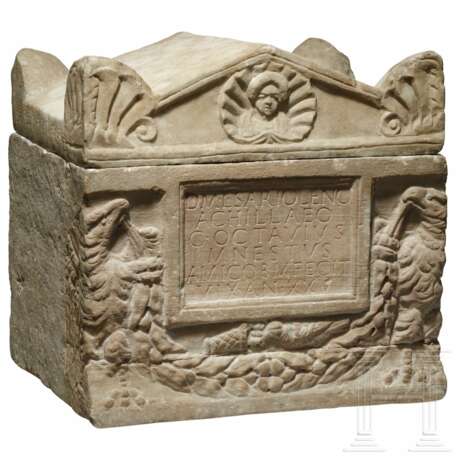ID 832786
Лот 44 | Aschenkiste aus Marmor, flavisch, letztes Viertel 1. Jhdt.
Оценочная стоимость
€ 20 000
Im Inneren des quaderförmigen Unterteils ein 28 cm tiefes Behältnis im Umfang von 17 x 22 cm. Die Innenwände des Behältnisses und der Boden vollständig mit Werkspuren des Meißels bedeckt. Die dicke Außenwand des Unterteils innen mit einer Randerhöhung, die in eine Nut auf der Unterseite des Deckels passt. Der Deckel in Gestalt eines niedrigen Satteldaches, dessen Ecken mit Akroteren verziert sind. Die Akrotere der Schauseite vorne und seitlich mit Palmetten. Das Innenfeld des Giebels der Schauseite zurückgesetzt, die Ränder mit einer Ritzlinie verziert. Mittig eine Muschel mit einem Frauenportrait, das sich durch eine für die Zeit der Flavier typische Frisur auszeichnet (Lockenturm oberhalb der Stirn und Flechtennest am Hinterkopf). Die Schauseite des Unterteils oben mittig mit einer gerahmten Schrifttafel mit vertieftem Innenfeld. Außen herum ein Relief: seitlich zwei Adler, die in ihren Schnäbeln eine Girlande halten, die unter der Schrifttafel durchhängt. Der Raum zwischen Unterkante der Schrifttafel und Girlande gefüllt mit einem Vogel, der Früchte aus einem umgekippten Korb pickt. Die Darstellung der Adler um die Ecke herum fortgeführt, aber nur noch mit Ritzlinien und nicht mehr im Relief auf vertieftem Untergrund.
Die Inschrift nennt den mit 25 Jahren verstorbenen Lucius Sariolenus Achillaeus, den Angehörigen einer plebejischen Familie senatorischen Ranges, dessen Freund Gaius Octavius Mnestus die Herstellung der Aschenkiste besorgte:
D(iis) M(anibus) L(ucio) SARIOLENO / ACHILLAEO / G(aius) OCTAVIVS / MNESTVS / AMICO B(ene) M(erenti) FECIT / VIX(it) AN(nos) XXV.
Abgesehen von einem horizontalen Sprung im unteren Teil auf der Schauseite, der sich auf der linken Seite bis zur Mitte und auf der rechten Seite ganz durchzieht, ausgezeichnet erhalten. In den Vertiefungen der Buchstaben gut sichtbare Reste roter Pigmente. Veröffentlicht in der Zeitschrift "L' Année épigraphique" 2006, 1825.
Provenienz: Aus französischer Privatsammlung, erworben vor 2000.
Cinerary urn in the shape of a miniature sarcophagus made of two parts with a width of 31 cm and a depth of 24 cm. Height without lid 21.5 cm, with lid 30 cm. Inside the cuboid lower part a box of 28 cm height, with a depth and width of 17 cm and 22 cm, respectively. The inner walls of the box and the bottom completely covered with traces of the chisel. The thick outer wall of the chest with a raised rim on the inside that fits into a groove on the underside of the lid. The lid in the shape of a low gabled roof, the corners of which are decorated with acroteria. The acroteria on the obverse and on the sides with palmettes. The interior field of the gable recessed at the front, the edges decorated with an incised line. In the centre a shell with a female portrait characterised by a hairstyle typical for the time of the Flavians (tower of curls above the forehead and nest of braided hair at the back of the head). On the face of the chest a framed inscription panel with a recessed inner field at the top centre, surrounded by a relief with two eagles on the sides holding a garland in their beaks that droops underneath the inscription plate. The space between the lower edge of the inscription panel and the garland is filled with a bird pecking fruit from an overturned basket. The depiction of the eagles continued around the corner, but only with incised lines and no longer in relief on a recessed background.
The inscription names Lucius Sariolenus Achillaeus, member of a plebeian family of senatorial rank, who died at the age of 25 and whose friend Gaius Octavius Mnestus arranged for the cinerary urn to be made:
D(iis) M(anibus) L(ucio) SARIOLENO / ACHILLAEO / G(aius) OCTAVIVS / MNESTVS / AMICO B(ene) M(erenti) FECIT / VIX(it) AN(nos) XXV.
Apart from a horizontal crack in the lower part on the obverse, which extends to the middle of the left side and over the entire right side, the cinerary urn is excellently preserved. Remnants of red pigments clearly visible in the depressions of the letters. Published in the journal "L' Année épigraphique" 2006, 1825.
Provenance: From a French private collection, acquired before 2000.
| Место происхождения: | Римская империя |
|---|
| Место происхождения: | Римская империя |
|---|
| Адрес торгов |
Hermann Historica Bretonischer Ring 3 85630 Grasbrunn / München Германия | ||||||||||||||
|---|---|---|---|---|---|---|---|---|---|---|---|---|---|---|---|
| Предосмотр |
| ||||||||||||||
| Телефон | +49 (0)89 5472 649 0 | ||||||||||||||
| Факс | +49 (0)89 5472 64999 | ||||||||||||||
| Комиссия | 25 % | ||||||||||||||
| Условия использования | Условия использования | ||||||||||||||
| Часы работы | Часы работы
|



